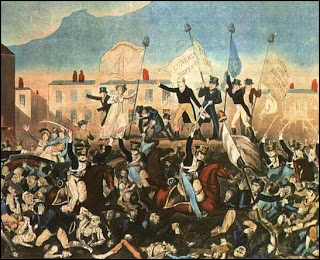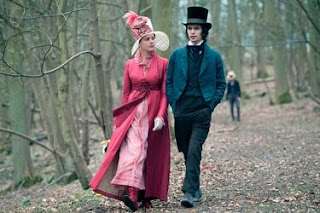I’m thrilled to welcome Ann Wass as our guest today. Ann is historian at Riversdale House Museum, MD, which hosts a battle reenactment of the Battle of Bladensburg on August 14 and other events throughout the year. Ann is author of Part 1 (the Federal era, 1786-1820), of the book, Clothing through American History: The Federal Era through Antebellum, 1786-1860. More here about the book.
As my specialty is dress in the United States, I have explored how American women kept up with the Regency fashions of their English sisters and the Empire fashions of their French ones. In Charleston, women “copied from the fashions of London and Paris” (Ramsay 1809, 409). In New York, women seemed “more partial to the light, various, and dashing drapery, of the Parisian belles, than to the elegant and becoming attire of our London beauties, who improve upon the French fashions” (Lambert 1810, 2:196-97).
By the late 1790s, French women wore slender, high-waisted dresses made of lightweight, clinging cotton muslins. Englishwomen generally modified the look, and most Americans did, too; emigrée Rosalie Calvert wrote, “In this more virtuous land only the contours are perceived through filmy batiste–a subtler fashion” (Callcott 1991, 34; even in France not everyone went to extremes. Maria Edgeworth wrote from Paris, “people need not go naked here unless they chuse it” [Colvin 1979, 27]). One American, though, enthusiastically adopted French fashions and became the talk of the town. In 1803, Betsy Patterson of Baltimore married Jerome Bonaparte, Napoleon’s younger brother. Jerome presented Betsy with gowns from France, and in Washington, DC, Margaret Bayard Smith saw “mobs of boys crowded round her splendid equipage to see what I hope will not often be seen in this country, an almost naked woman” (Smith 1906/1965, 46-47).
How did women learn about the latest fashions from abroad? Some, like Mrs. Bonaparte, received gowns from Europe, while others went shopping there themselves. Elizabeth Monroe and Sarah Bowdoin, both married to diplomats, shopped in Paris and London. Dolley Madison commissioned Ruth Barlow, wife of the minister to France, to send her “large Headdresses a few Flowers, Feathers, gloves & stockings (Black & White) or any other pritty thing” (Shulman 2007).
 Ladies also bought imported goods in American shops. In 1805, New York merchant Joseph Kaumann advertised “3 trunks ladies Hats and Bonnets/1 do. ready made Gowns” from Nantes, one of France’s leading seaports. In 1807, the French milliner Mme. Bouchard “just received from Paris, the newest fashions, more elegant than have yet been seen in this city.” Her English rival, Mrs. Toole, also received “a very handsome assortment” including bonnets, shawls, veils, and ribbons from Paris (though she was English, she no doubt knew her clientele would admire the latest Parisian fashions.)
Ladies also bought imported goods in American shops. In 1805, New York merchant Joseph Kaumann advertised “3 trunks ladies Hats and Bonnets/1 do. ready made Gowns” from Nantes, one of France’s leading seaports. In 1807, the French milliner Mme. Bouchard “just received from Paris, the newest fashions, more elegant than have yet been seen in this city.” Her English rival, Mrs. Toole, also received “a very handsome assortment” including bonnets, shawls, veils, and ribbons from Paris (though she was English, she no doubt knew her clientele would admire the latest Parisian fashions.)
Other merchants sold English goods. In 1805, Baltimore milliner Miss Hunter imported fall fashions from London. Even in the midst of the War of 1812, while there were major disruptions in trade, Mrs. Gouges in Baltimore sold fashions from both England (the enemy!) and France. It may have been Mrs. Gouges that Betsy Bonaparte had in mind when she wrote Dolley Madison in 1813, “There are in the Shops in Baltimore French Gloves Fashions &c: & the little taste possessed by me shall be exerted, in  Selecting, if I obtain your permission, whatever you may require.” Mrs. Madison replied, “I will avail myself of your taste, in case you meet with anything eligant, in the form of a Turban, or even anything brilliant to make me. . . .” (Shulman 2007).
Selecting, if I obtain your permission, whatever you may require.” Mrs. Madison replied, “I will avail myself of your taste, in case you meet with anything eligant, in the form of a Turban, or even anything brilliant to make me. . . .” (Shulman 2007).
American women also studied European fashion plates for ideas to make their own clothes. These hand colored engravings struck from steel plates were published in English and French periodicals. Rosalie Calvert asked her sister in Antwerp for several of “those little engraved sketches showing morning and evening dress. . . with them we will be able to copy your styles.” (Callcott 1991, 347). New Yorker David Longworth subscribed to the English Gallery of Fashion and exhibited the plates to fashion-hungry women for a small fee (Majer 1989, 220). Josephine DuPont sent Margaret Manigault plates from Paris in 1799, and Margaret thanked her friend for the “curious, & entertaining, & astonishing, & very acceptable Costumes Parisiens” (Low 1974, 51). In 1814, Margaret’s daughter received “a fine collection of ‘Belle Assemblies”’ from Mrs. Dashkov, wife of the Russian minister to the United States (Manigualt 1976, 23). La Belle Assemblée, despite its French name, was published in England and was difficult to obtain during the war years.
 Once the war was over, American women again had ready access to European fashions. In Philadelphia, Mary Bagot, wife of the British minister, found, “every sort & kind of French, Indian & English goods to be had-excellent of their kind & not dear” (Hosford 1984, 43). Even out west, women kept up appearances. A Scotsman observed, “I have seen some elegant ladies by the way. Indeed, I have often seen among the inhabitants of the log-houses of America, females with dresses composed of the muslins of Britain, the silks of India, and the crapes of China” (Flint 1822/1970, 286).
Once the war was over, American women again had ready access to European fashions. In Philadelphia, Mary Bagot, wife of the British minister, found, “every sort & kind of French, Indian & English goods to be had-excellent of their kind & not dear” (Hosford 1984, 43). Even out west, women kept up appearances. A Scotsman observed, “I have seen some elegant ladies by the way. Indeed, I have often seen among the inhabitants of the log-houses of America, females with dresses composed of the muslins of Britain, the silks of India, and the crapes of China” (Flint 1822/1970, 286).
Illustrations:
Advertisement, Baltimore American & Commercial Daily Advertiser
Merino Redingote, Costume Parisien, 1812
Ball Dress, La Belle Assemblée, August 1818
REFERENCES
Callcott, Margaret Law, ed. 1991. Mistress of Riversdale. Baltimore: Johns Hopkins University Press.
Colvin, Chistina, ed. 1979. Maria Edgeworth in Franch an Switzerland. Oxford: Clarendon Press.
Flint, James. 1822/1970. Letters from America. Repr. New York: Johnson Reprint Corporation.
Hosford, David. 1984. Exile in Yankeeland: The Journal of Mary Bagot, 1816-1819. Records of the Columbia Historical Society 51: 30-50.
Lambert, John. 1810. Travels through Lower Canada, and the United States of North America, in the Years 1806, 1807, and 1808. 3 vols. London: Richard Phillips.
Low, Betty-Bright P. 1974. Of Muslins and Merveilleuses: Excerpts from the Letters of Josephine du Pont and Margaret Manigault. Winterthur Portfolio 9: 29-75.
Majer, Michele. 1989. American Women and French Fashion. In The Age of Napoleon: Costume from Revolution to Empire 1789-1815, ed. Katell le Bourhis. 217-237. New York: Metropolitan Museum of Art.
Manigault, Harriet. 1976. The Diary of Harriet Manigault 1813-1816. Rockland, ME: Maine Coast Publishers.
Ramsay, David. 1809. The History of South-Carolina: from its First Settlement in 1670, to the Year 1808. Charleston: David Longworth.
Shulman, Holly C. 2007. Dolley Madison Digital Edition. Version 2007.07. http://rotunda.upress.virginia.edu/index.php?page_id=Home.
Smith, Margaret Bayard. 1906. The First Forty Years of Washington Society. Ed. Gaillard Hunt. New York: Scribner.

 Tudor fashions, from early Tudor to Elizabethan frufferies…
Tudor fashions, from early Tudor to Elizabethan frufferies…




















